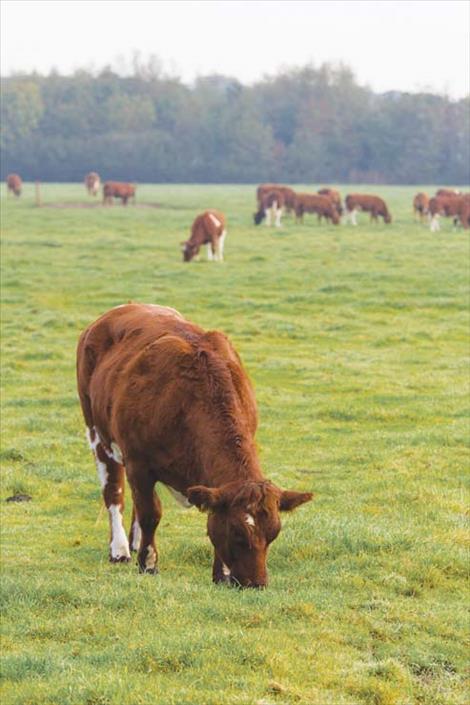Pandemic prices could shutter Montana ranches
Hey savvy news reader! Thanks for choosing local.
You are now reading
1 of 3 free articles.
MONTANA – Some Montana ranchers will likely go out of business due to the economic fallout of the COVID-19 pandemic, the Department of Livestock told state legislators last week.
Montana cattle producers are facing enormous uncertainty after restaurant closures and COVID-19 outbreaks at meat processing plants across the country caused severe disruptions in the meat supply chain and reduced demand for cattle. Cattle prices have dropped about 30 percent since January.
“Potentially, we will see some attrition in the number of producers, as some producers may not be able to make it through the term” said Mike Honeycutt, executive officer of the Montana Department of Livestock, during an interim Economic Affairs Committee meeting on Thursday, April 30.
The majority of Montana ranchers are cow-calf producers, breeding and grazing in Montana before selling the larger calves to feedlots out of state. Recent projections from Oklahoma State University predict Montana ranchers may have to sell those cattle for $111 less per head.
“Ranchers are scared as hell,” said Gilles Stockton, a rancher near Grass Range and president of the Montana Cattlemen’s Association. “They have no clue what their calves might be worth in the fall.”
Stockton said he’s especially concerned about younger ranchers and those that are highly leveraged with debt. Stockton said he can see the pandemic-pinched market putting ranchers out of business.
Though agriculture remains Montana’s top industrial sector, the value of animal production in Montana fell from $2.2 billion in 2014 to $1.5 billion in 2018, according to the U.S. Department of Agriculture.
“With this disruption, it just compounds the losses,” Stockton said. “It’s harder and harder to talk your banker into supporting your next year.”
Right now, ranchers are having a hard time finding anyone to buy their cattle, and anyone who finds a buyer is losing money, Honeycutt said. Over the next year, Honeycutt, said he expects ranchers to reduce the size of their herds across the state.
“We do have to be prepared for some systemic long-term impacts to our system,” Honeycutt said.
Effects go beyond cattle
Upheavals in ranching will have “cascading impacts” on other businesses and state revenue, Honeycutt said. Though cattle producers are the largest sector of Montana’s livestock economy, other types of producers are also impacted by the pandemic.
“I would say there’s not been any sector of the animal protein and livestock industry that has not been affected: cattle, swine, poultry, sheep and lambs, wool,” Honeycutt said.
Montana’s dairy producers are dumping milk. Other states have already seen hogs and chickens euthanized, and Montana is “getting its carcass disposal plant ready to go,” Honeycutt said. “We typically use those plants to deal with a foreign animal disease outbreak. I did not realize we might have to be executing those plans for this type of a crisis,” he said.
Montana swine producers are losing $5 per head on any animal they ship right now, Honeycutt said. Over the next few months, he expects producers to slow the growth of their animals and hold onto them as long as possible.
USDA guidance
Congress has passed $16 billion in coronavirus relief funds aimed at agriculture, but it’s unclear when that money will be available and how much will go to each industry, Honeycutt said.
“This relief needs to come soon,” he said.
The Interim Economic Affairs Committee voted to write a letter to the USDA asking for guidance about when the $16 billion will be available to ag producers.
Additionally, with processing facilities having gone offline in April, food banks that have recently seen up to 300 percent increases in demand have been unable to get meat. Honeycutt encouraged the committee to ask the USDA for waivers to allow custom meat processors in Montana to slaughter livestock for food banks during the pandemic. The committee agreed. Senators Jon Tester and Steve Daines and Gov. Steve Bullock have also asked the USDA for a waiver.
“It really concerns me that we’re dumping and euthanizing and we’re creating a big old circle of food shortage,” said Chairwoman Sharon Stewart Peregoy, a Democrat from Crow Agency. “This really shows us we have the capacity to be self sufficient, and we need to return to that.”
Stockton said he doesn’t have statistics other than market price on how ranchers are being affected, but that current conditions could be a breaking point for many.
“We’ve been going out of business at a steady rate for decades,” said Stockton, 74. “It’s been a controlled going of business.”
He then navigated a mental map of the road bounding his Fergus County ranch, counting from his start in ranching. “One, two, three, four,” he said, pausing between each number to imagine a bygone ranch. “Five, six, seven. Just in this valley, along this road, there were seven independent farm ranchers. Today there’s three. We just had to get bigger and bigger.”
Honeycutt told the committee he’s not sure today’s ranchers will be able to absorb those opportunities like they have in the past.
“Typically what has happened is, as producers go out, someone usually takes on that production,” Honeycutt said. “I don’t know that we will continue to see that trend.”
Johnathan Hettinger is a journalist based in Livingston. Originally from Central Illinois and a graduate of the University of Illinois, he has worked at the Midwest Center for Investigative Reporting, the Livingston Enterprise and the (Champaign-Urbana) News-Gazette.
















